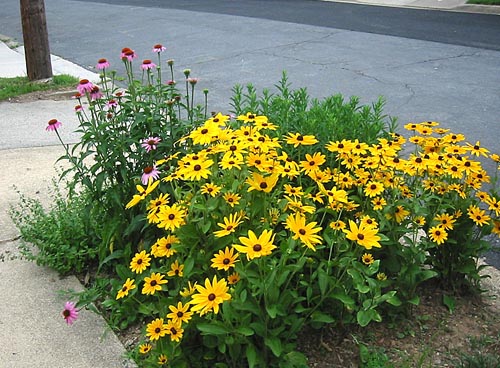Make Your Hell Strip Less Fiendish
by Mary Ellyn Perkowski, Fairfax Master Gardener
People call it the “hell strip” –that often barren, desiccated, hard-packed sliver of earth between the sidewalk and the curb that bedevils many homes in many neighborhoods. A hell strip may be only a small portion of your yard, but how it looks can have a dramatic impact on curb appeal, the overall impression passersby get of your home.

Hell strip landscaped with easy-care native perennials of echinacea, rudbeckia, and aster
If the hell strip on your property needs help, you can find plenty of beautification ideas on the Internet, which offers pictures and detailed information about plants that tend to do well in hell strips. Before beginning any work, however, it is important to remember that the small piece of land does not belong to you, the homeowner. As a right-of-way, it is public property and is regulated by the Virginia Department of Transportation (VDOT). A homeowner cannot improve it without first getting a Land Use Permit from VDOT. The Code of Virginia does not allow any exceptions to this — no matter how minor the work.
In addition, VDOT has a host of rules and guidelines for planning and executing a hell-strip makeover. Among the points to keep in mind:
Plant suitable plants
 Any plant in the right-of-way must be drought resistant, salt tolerant and non-invasive. In addition, VDOT encourages homeowners to choose native plants. Besides being environmentally friendly, native plants are easier to maintain because they are well adapted to conditions in our area. A great source of information about native plants is the website, Plant NOVA Natives, which offers the guide, Native Plants for Northern Virginia. Another helpful resource is Native Plants for Wildlife Habitat and Conservation Landscaping, published by the U.S. Fish and Wildlife Service. Both publications are available in print or online.
Any plant in the right-of-way must be drought resistant, salt tolerant and non-invasive. In addition, VDOT encourages homeowners to choose native plants. Besides being environmentally friendly, native plants are easier to maintain because they are well adapted to conditions in our area. A great source of information about native plants is the website, Plant NOVA Natives, which offers the guide, Native Plants for Northern Virginia. Another helpful resource is Native Plants for Wildlife Habitat and Conservation Landscaping, published by the U.S. Fish and Wildlife Service. Both publications are available in print or online.
Consider mature size
In the past, many communities opted to plant trees such as oaks and maples to line their streets but, as the trees grew larger, their roots destroyed sidewalks and sewage systems, and the trees had to be cut down. Current regulations state that no plants will be approved that have root systems that will damage the sidewalk, curb, roadway or roadway drainage systems. In addition, to comply with the Americans with Disabilities Act, plants cannot obstruct the sidewalk. They also cannot obstruct the curb/ditch line or block the line-of-sight for driveways or intersections.
Opt for easy upkeep
Any  planting that is considered high maintenance (needs pruning and shaping) will not be approved. Water requirements are important to keep in mind, too, as no irrigation systems are permitted in the utility strip. Furthermore, VDOT will not assume responsibility for upkeep if the homeowner who planted the strip moves away.
planting that is considered high maintenance (needs pruning and shaping) will not be approved. Water requirements are important to keep in mind, too, as no irrigation systems are permitted in the utility strip. Furthermore, VDOT will not assume responsibility for upkeep if the homeowner who planted the strip moves away.
If, given all these considerations, you are still ready to take on the challenging but creative task of beautifying a hell strip, start by looking at VDOT’s website for NOVA Permits for Arlington and Fairfax Counties. As the website points out, the following forms are required with every Land Use Permit application
- Land Use Permit Application (LUP-A)
- Permittee Agreement for Land Use Permit Issuance (LUP-SPG Special Provisions – General)
- Erosion & Sediment Control Contractor Certification (LUP-ESCCC)
- VDOT Work Zone Traffic Control Certification (LUP-WZTCC)
In addition, the Homeowner Maintenance Agreement for Landscaping is used for planting and any other non-transportation-related structures to be placed in the right-of-way and maintained by private entities.
Fill out the VDOT forms, read the recommendations, and choose some lovely — and appropriate – plants, and you will be on your way toward turning that hell strip into a heavenly mini-garden in front of your home.